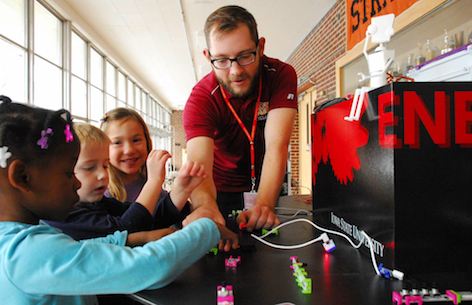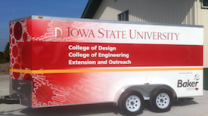AMES, Iowa – Sure they flock to 3-D movies and send Instagrams with a frenzy, but can they model a tractor part with a MakerBot? Or test ergonomic design with Oculus Rift?
Although Iowa’s K-12 population is tech savvy, they still have more to learn before maneuvering through advanced technology to solve problems in design and manufacturing, says an Iowa State University industrial design professor.
David Ringholz, professor and chair of ISU’s Department of Industrial Design, challenged an industrial design graduate studio last summer to create a mobile classroom for technology outreach to Iowa schools. This fall, FLEx (Forward Learning Experience) has been on the road, providing K-12 students and teachers with hands-on experiences with virtual reality, Oculus Rift immersive visualization, interactive circuit building with Little Bits and 3-D printers.

Lecturer Pete Evans gives Stratford students their first experience with 3-D glasses. Photo by Alison Weidemann.
ISU design faculty and students introduced the trailer full of high-tech workstations during the Science Center of Iowa’s Mini Maker Faire in September. In October, they made two stops: for a five-day stint in October with the Clarion-Goldfield-Dows Middle School; and as part of a STEM (Science, Technology, Engineering, Math) educator training and a separate STEM faire, both at Des Moines Area Community College. And this week, the mobile classroom is up and running at the Stratford Elementary School as part of the school’s Maker Space Project kick-off.
“FLEx can be a lot of things,” Ringholz said. “We can customize the modules to accommodate different age groups or various advanced technologies.”
Five days in Clarion
In Clarion, the FLEx trailer was set up in the showroom at Hagie Manufacturing, an agricultural sprayer manufacturer. Four workstations were rolled out from the trailer, which served as the virtual reality room for object and environment manipulation. In addition to Oculus Rift equipment, other workstations provided electronic circuit experimentation, a CNC (computer numerical control) router for complex-precision material cutting and the MakerBot for 3-D printing.
All 4th through 8th graders experienced the advanced technologies in groups of 25 for 90-minutes. On Saturday, the Iowa State team worked with a 4-H STEM group.
“Having the students come here to Hagie has been a fantastic experience,” said Pete Evans, a lecturer in architecture and industrial design and FLEx coordinator. His summer studio class created the mobile classroom.
“Hagie uses some of the same software for 3-D printing and prototyping. Many of the students' families work here, so they can start to make connections to real-world applications. It’s not abstract for them,” he said.
The future of solving problems
During the sessions in Clarion, Evans talked to the students about the scientific method, design thinking and engineering cycles as different problem-solving methods. He explained making and breaking prototypes as a way to learn how something works and fails. And he referred to the importance of 21st century skills such as creativity, collaboration, critical thinking and communication.
“Design and STEM all fit into that same space for learning and thinking,” Evans said. “Today we have many tools and ways of thinking that fit into that problem-solving idea. There are different ways to see the world around you."

Oculus Rift in Clarion.
As he invited the students to experience the Oculus Rift, Evans said, “It might seem like a game now, but it will change how you’re educated in just two to five years.
“Use these tools, see how they work, experience them and then think about problem solving. These technologies will soon be how people solve many problems,” he told the students.
Evans said the students had seen some technologies and heard of others. He was pleased about their ease of use with them.
"They're very hands on and really quick to get into it. They’re like fish in water. It’s been fun to see that," he said. "And they walk away very enthused and excited. To have a student walk away excited about STEM, about design is fantastic. I’m very happy to provide that opportunity from Iowa State."
FLEx moving forward
Ringholz plans on expanding the pilot outreach program, which has been funded by Iowa State’s Strategic Initiative on interdisciplinary design education and research, and the industrial design department. FLEx is a collaboration between the colleges of Design and Engineering, in association with ISU Extension and Outreach.
Ringholz and the FLEx team are creating curricular materials and resources for teachers to integrate these advanced technologies into the classroom. And they are applying for grant funding through the National Science Foundation’s K-12 STEM outreach program.
“We believe in taking these technologies out into the community because there’s a need,” Ringholz said.

Interactive circuit building with ISU industrial design grad student Dan Neubauer at Stratford Elementary. Photo by Alison Weidemann.
